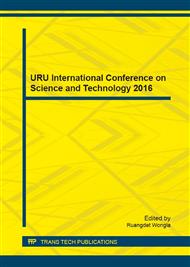p.42
p.47
p.54
p.60
p.65
p.70
p.75
p.82
p.91
Nutritional Value and Anthocyanins of Mulberry and Roselle Mixed Fruits Jam
Abstract:
Mulberry and roselle are widely consumed in Thailand both as fresh and in processed forms. The objectives of this study were to develop mulberry and roselle mixed fruits jam and to study the nutritional value and anthocyanins content of the finished product having highest sensory score. Formulations of mixed fruits jam based on roselle and mulberry in five different ratios, 70/30, 60/40, 50/50, 40/60 and 30/70 was developed. Sensory analysis was carried out with 10 non-trained panelists using a structured 9-point hedonic scale to evaluate sensory acceptance. The highest score of overall acceptance of mixed fruits jam was analyzed nutritional value, total anthocyanins content, total microorganisms, and yeast and mold. The results showed that no significant difference of sensory scores from all formulations of mixed fruit jam was found (P > 0.05) in all sensory attributes, and the liking scores were in the range of 6-7 which mean slightly to moderately liking. However, mixed fruits jam based on roselle and mulberry in the ratios of 70/30 was the highest score for overall acceptability (6.4). Thus, the nutritional value of this mixed fruits jam product found that moisture content, carbohydrate, protein, fat and total minerals were 24.96%, 74.03%, 0.34%, 0.01% and 0.66% respectively. The pH, total soluble solids and total anthocyanins content of this product were 2.98, 68 oBrix and 538.84 mg/100 g. Microbiological analyses revealed that the mixed fruit jam product showing the highest overall acceptability presented a total number of microorganisms, and yeasts and molds < 10 cfu/g, which is above the expected level of jam community standards of Thailand. Thus, this mixed fruits jam product may have great potential for sales due to high nutritional value and anthocyanins content because anthocyanins were considered to play an important role as dietary antioxidants for the prevention of oxidative damage in living system.
Info:
Periodical:
Pages:
65-69
Citation:
Online since:
October 2016
Authors:
Keywords:
Permissions:
Share:
Citation:


